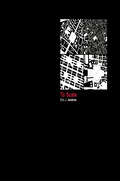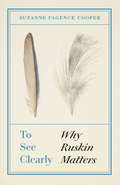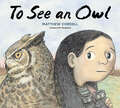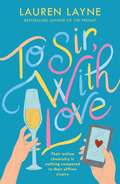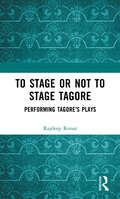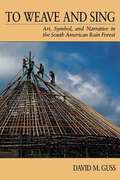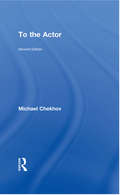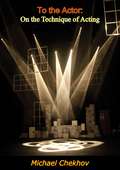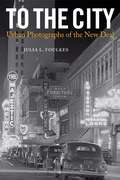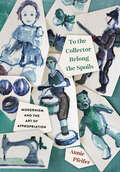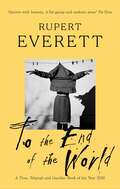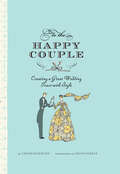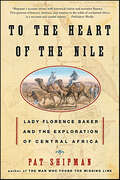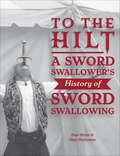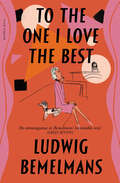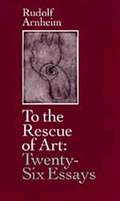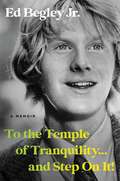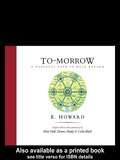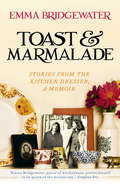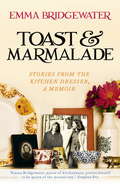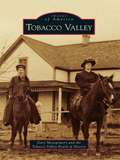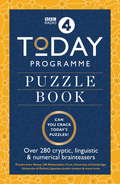- Table View
- List View
To Scale: One Hundred Urban Plans
by Eric JenkinsHow big is Moscow’s Red Square in comparison to Tiananmen Square? Why are there fewer public squares in Japan than in Italy? What lessons might be found in the plan of Savannah, Georgia’s historic district? To Scale is a collection of plans of urban spaces drawn at the same scale to help answer these questions by providing a single and accurate resource of urban plans for architects, urban designers, planners and teachers, and students. The book contains one hundred figure-ground plans from seventy-eight cities around the world, describing an identical area (half a kilometer square) for each urban space. Accompanying each plan are photographs, diagrams and text that illustrate essential aspects of the plan or urban space for the designer. This compilation is an excellent resource helping to visualize, compare and reconceptualize urban design for students wanting to understand the lessons of existing cities and the making of urban spaces.
To See Clearly: Why Ruskin Matters
by Suzanne Fagence Cooper'To see clearly is poetry, prophecy, religion, all in one'John Ruskin - born 200 years ago, in February 1819 - was the greatest critic of his age: a critic not only of art and architecture but of society and life. But his writings - on beauty and truth, on work and leisure, on commerce and capitalism, on life and how to live it - can teach us more than ever about how to see the world around us clearly and how to live it.Dr Suzanne Fagence Cooper delves into Ruskin's writings and uncovers the dizzying beauty and clarity of his vision. Whether he was examining the exquisite carvings of a medieval cathedral or the mass-produced wares of Victorian industry, chronicling the beauties of Venice and Florence or his own descent into old age and infirmity, Ruskin saw vividly the glories and the contradictions of life, and taught us how to see them as well.
To See Them Run: Great Plains Coyote Coursing
by Eric A. EliasonTo See Them Run explores how and why Great Plains hunters have chased coyotes with greyhounds and other sight hounds since before George Armstrong Custer. Though a well-developed, long-lived, widespread, and undeniably enthralling tradition, the practice remains little known, even to those living in Oklahoma, Nebraska, and South Dakota, where the tradition is common. Coyote coursing, hunting with greyhounds launched from specially made pickup rigs, is a hobby by locals, for locals, and it has remained a quintessentially vernacular enterprise occupying a rung below the Plains’ prestige forms of animal training and interaction—namely with horses and cattle. The coyote coursing tradition provides an ideal setting for exploring the relationship between animals and the study of folklore. The book examines the artistry, thrills, values, camaraderie, economy, and controversies of this uncommercialized and never-before-studied vernacular tradition. Through ethnographic photographs and authentic collected commentary from participants, this book uncovers how hunting dogs and coyotes both have shaped and been shaped by human aesthetic sensibilities in ongoing folkloric and biological processes. Author Eric A. Eliason and photographer Scott Squire discover deep and sophisticated local knowledge in a unique interaction with the natural ecologies of the great North American prairie.
To See an Owl
by Matthew CordellAn endearing story about a girl&’s efforts to spot an owl from the Caldecott Medal winning creator of Wolf in the Snow. This gorgeous picture book that encourages patience and perseverance will resonate with readers of all ages who have longed to see one of these elusive creatures in the natural world.When will I find you?Where could you be?What will it take?To see an owl.Silent and wide-eyed, owls are hidden creatures of the night. Janie has always dreamed of finding one. She searches everywhere for signs of an owl – on the open prairie for short-eared owls, on the beach for snowy owls, and for great horned owls in the woods near her home. But months go by, and she sees no owls. She wonders, what will it take to see an owl?Her teacher, Mr. Koji, a fellow bird-lover, shares that he, too, waited a long time to see an owl. He assures her, &“If you are very quiet and very patient, and if you look very close, you might just find them.&” When the snow begins to fall, Janie and her mother head into the woods again, and as she looks carefully, hidden high up in the trees, what she sees is pure magic.From Matthew Cordell, the creator of Wolf in the Snow that was awarded the Caldecott Medal, comes this beautiful story about quiet perseverance that will resonate with anyone who has experienced the anticipation of discovering a rare treasure in the wild.
To Sir, With Love: Their online chemistry is nothing compared to their offline rivalry in this sparkling enemies-to-lovers rom-com!
by Lauren Layne'This is romantic comedy PERFECTION and if you don't read it, you really are missing out' 5* reader review'The romance, writing style and wit in this book is second to none. I have nothing but praise for this book' 5* reader review'I devoured this book in a single morning, and I can't wait to reread it' 5* reader review'The overall feeling from reading this book is like being enveloped in a warm hug from that special someone in your life' 5* reader review'The New York backdrop was classic Lauren Layne as was the banter and I loved her modern day spin on this fairy tale romance' 5* reader reviewLove Is Blind meets You've Got Mail in this laugh-out-loud romantic comedy following two thirty-somethings who meet on a blind dating app - only to realize that their online chemistry is nothing compared to their offline rivalry.Perpetually cheerful and eager to please, Gracie Cooper strives to make the best out of every situation. When her father dies, she sets aside her dreams of pursuing her passion for art to take over his Midtown Manhattan champagne shop. She soon finds out that the store's profit margins are being squeezed and a giant corporation headed by the impossibly handsome, but irritatingly arrogant Sebastian Andrews is proposing a buyout. Gracie can't bear the thought of throwing away her father's dream and, overwhelmed, she seeks advice and solace from the faceless 'Sir', with whom she connected on a blind dating app where matches get to know each other before exchanging real names or photos. But although Gracie finds herself slowly falling for Sir online, she has no idea she's already met him in real life...and they can't stand each other.'The word charm is pretty much synonymous with Lauren Layne' Hypable'Fans of Nora Ephron will adore this' Lori Nelson Spielman''As light and refreshing as a glass of champagne...will have you smiling from the first swoon-worthy page to the last' Jill Shalvis'Lauren Layne's books are as effervescent and delicious as a brunch mimosa. As soon as you read one, you're going to want another - IMMEDIATELY!' Karen Hawkins, New York Times bestselling author 'The queen of witty dialogue' Rachel Van Dyken, New York Times bestselling author 'Lauren Layne is a master at sexy banter and funny dialogue' BookPageWant more fun, fresh, flirty and very sexy rom-com? Check out all of Lauren's books! Don't miss:Made in ManhattanThe PrenupThe Central Park Pact seriesOxford seriesWedding Belles seriesI Do, I Don't seriesLove, Unexpectedly series
To Stage or Not to Stage Tagore: Performing Tagore's Plays
by Rajdeep KonarRabindranath Tagore (1861‒1941) was a prolific playwright with more than thirty plays to his credit. He is also known for his life-long, passionate engagement with theatre, first at Jorasanko and then at Santiniketan, in multiple roles as actor, director, singer, musician. However, during his own life-time and even after his demise, his experimental plays have proved challenging for directors to stage. Time and again they have been written off as unstageable by prominent theatre makers. Further complications have arisen from the presence of a spectre of authority around Tagore and his plays often promoted by Visva-Bharati, the institution he founded and which held the copyright of his works till 2001. This book travels through time and space intending to untangle the enigma presented by Tagore’s plays. The book on one hand immerses itself into the archive of Tagore’s plays and his dramaturgy of them in order to problematize the ways in which they have been interpreted. On the other, it also engages with productions of Tagore’s plays during and after his life-time to understand the challenges directors have faced while staging them and the strategies they have embraced to circumvent them. While performing a subjective critical reading of the Tagore theatre-archive, an underlying objective of the book remains to understand the very concept of the archive, as it manifests itself in contemporary dramatic theatre.
To Weave and Sing: Art, Symbol, and Narrative in the South American Rain Forest
by David M. GussTo Weave and Sing is the first in-depth analysis of the rich spiritual and artistic traditions of the Carib-speaking Yekuana Indians of Venezuela, who live in the dense rain forest of the upper Orinoco.
To the Actor: On the Technique of Acting
by Michael Chekhov Mala PowersMichael Chekhov's classic work To the Actor has been revised and expanded by Mala Powers to explain, clearly and concisely, the essential techniques for every actor from developing a character to strengthen awareness. Chekhov's simple and practical method – successfully used by professional actors all over the world – trains the actor's imagination and body to fulfill its potential. To the Actor includes a previously unpublished chapter on 'Psychological Gesture', translated into English by the celebrated director Andrei Malaev - Babel; a new biographical overview by Mala Powers; and a foreword by Simon Callow. This book is a vital text for actors and directors including acting and theatre history students.
To the Actor: On the Technique of Acting
by Michael Chekov Yul BrynnerIn To the Actor Michael Chekhov has recorded brilliantly the results of his many years of experimenting, testing and verifying in the professional theater and schools of the theater. He brings to actors far greater insight into themselves and the characters they are to portray, which enables them to approach any role with new ease and skill.“To the Actor is by far the best book that I have read on the subject of acting. Actors, directors, writers and critics will be grateful for it. It should prove enlightening to theatergoers who wish to deepen their appreciation for fine acting and thus help to invigorate the theatrical art.”—Gregory Peck“I think without a doubt every creative person in the theater will want to have it as a constant reference book, outside of its being, in my opinion, absorbing and entertaining reading.”—Yul Brynner (from the Preface)“One of the most remarkable and practical books on the technique of acting I have ever read....Enthusiastically recommended to all theatre collections of whatever size.”—Library Journal
To the City: Urban Photographs of the New Deal
by Julia L. FoulkesIn the 1930s and 1940s, as the United States moved from a rural to an urban nation, the pull of the city was irrepressible. It was so strong that even a photographic mission designed to record the essence of rural America could not help but capture the energy of urbanization too. To the Cityshowcases over 100 photographs from the Farm Security Administration (FSA) project along with extracts from the Works Progress Administration (WPA) guidebooks and oral histories, to convey the detail and dimensions of that transformation. This artfully grouped collection of photographs includes magnificent images by notable photographers Dorothea Lange, Walker Evans and Gordon Parks, among many others. Foulkes organizes this history of Americana into five themes: Intersection; Traffic; High Life and Low Life; The City in the Country; and Citizens to illuminate the changes in habits, landscapes, and aspirations that the march to cities encompassed. As the rural past holds symbolic sway and the suburb presents demographic force, the urban portion of our history--why and how cities have been a destination for hope--recedes from view. To the Cityis a thoughtful, engaging reminder. This book will make an excellent addition to undergraduate courses in U. S. urban history.
To the Collector Belong the Spoils: Modernism and the Art of Appropriation
by Annie PfeiferTo the Collector Belong the Spoils rethinks collecting as an artistic, revolutionary, and appropriative modernist practice, which flourishes beyond institutions like museums or archives. Through a constellation of three author-collectors—Henry James, Walter Benjamin, and Carl Einstein—Annie Pfeifer examines the relationship between literary modernism and twentieth-century practices of collecting objects. From James's paper hoarding to Einstein's mania for African art and Benjamin's obsession with old Russian toys, she shows how these authors' literary techniques of compiling, gleaning, and reassembling constitute a modernist style of collecting which that reimagines the relationship between author and text, source and medium. Placing Benjamin and Einstein in surprising conversation with James sharpens the contours of collecting as aesthetic and political praxis underpinned by dangerous passions. An apt figure for modernity, the collector is caught between preservation and transformation, order and chaos, the past and the future.Positing a shadow history of modernism rooted in collection, citation, and paraphrase, To the Collector Belong the Spoils traces the movement's artistic innovation to its preoccupation with appropriating and rewriting the past. By despoiling and decontextualizing the work of others, these three authors engaged in a form of creative plunder that evokes collecting's long history in the spoils of war and conquest. As Pfeifer demonstrates, more than an archive or taxonomy, modernist collecting practices became a radical, creative endeavor—the artist as collector, the collector as artist.
To the End of the World: Travels with Oscar Wilde
by Rupert EverettA Times, Telegraph and Guardian Book of the Year 2020 'Quivers with honesty, A-list gossip and sardonic prose' The Times'Everett is a deliciously gifted writer. Nothing and no one escapes his attention' ObserverIn his highly anticipated third memoir, Rupert Everett tells the story of how he set out to make a film of Oscar Wilde's last days, and how that ten-year quest almost destroyed him. (And everyone else.)Travelling across Europe for the film, he weaves in extraordinary tales from his past, remembering wild times, freak encounters and lost friends. There are celebrities, of course. But we also meet glamorous but doomed Aunt Peta, who introduces Rupert (aged three) to the joys of make-up. In '90s Paris, his great friend Lychee burns bright, and is gone. While in '70s London, a 'weirdly tall, beyond size zero' teenage Rupert is expelled from the Central School of Speech and Drama. Unflinchingly honest and hugely entertaining, To the End of the World offers a unique insight into the 'snakes and ladders' of filmmaking. It is also a soulful and thought-provoking autobiography from one of our best-loved and most talented actors and writers.
To the Happy Couple: Creating a Great Wedding Toast with Style
by Sarah McElwainNow here's something worth raising a glass to: the perfect how-to guide and resource for preparing, writing, and presenting the best wedding toast ever (butterflies not included). With clear explanations of who traditionally offers a toast and when, To the Happy Couple also gives useful information on fitting toasts for rehearsal dinners, bridal showers, and bachelor parties. Tips include avoiding the pitfalls of public speaking and advice on which topics work well and which should be avoided (don't bring up that first marriage...). There are plenty of suggestions for finding quotes, whether from song lyrics, poems, or other sources, examples of how to use them to enhance and personalize the message, plus a variety of quotes in the back of the book to provide additional inspiration. Beautifully illustrated throughout with whimsical drawings, To the Happy Couple is both a practical guide and a lovely gift for anyone who has ever had to say, "I'd like to make a toast..."
To the Heart of the Nile: Lady Florence Baker and the Exploration of Central Africa
by Pat ShipmanIn 1859, at age fourteen, Florence Szász stood before a room full of men and waited to be auctioned to the highest bidder. But slavery and submission were not to be her destiny: Sam Baker, a wealthy English gentleman and eminent adventurer, was moved by compassion and an immediate, overpowering empathy for the young woman, and braved extraordinary perils to help her escape. Together, Florence and Sam -- whose love would remain passionate and constant throughout their lives -- forged into literally uncharted territory in a glorious attempt to unravel a mysterious and magnificent enigma called Africa.A stunning achievement, To the Heart of the Nile is an unforgettable portrait of an unforgettable woman: a story of discovery, bravery, determination, and love, meticulously reconstructed through journals, documents, and private papers, and told in the inimitable narrative style that has already won Pat Shipman resounding international acclaim.
To the Hilt: A Sword Swallower's History of Sword Swallowing
by Marc Hartzman Dan MeyerTo the Hilt is a riveting exploration into the mysterious and dangerous world of sword swallowing, charting its history from ancient rituals to modern-day performances. Cowritten by world-renowned sword swallower Dan Meyer and celebrated sideshow historian Marc Hartzman, this volume delves into the lives of over 100 sword swallowers. Meyer, with his numerous world records and vast experience, provides an insider&’s perspective that is unmatched, while Hartzman adds depth with his historical knowledge and engaging writing style. Key Features:Definitive compendium of historical biographies: Highlights the captivating lives of historical sword swallowers from the 1700s to the present, many of whom have never been profiled in other books.Behind the scenes with modern performers: Provides an inside look at the wild stories and experiences of modern sword swallowers, who account for one out of every 300 million people alive today.Expert perspectives: Readers will learn from Dan Meyer, the world&’s leading expert on sword swallowing and viral TEDx presenter, as he shares his unique life experiences and relatable life lessons in his introductory essay.Rare imagery: Contains a treasure trove of rare photographs and ephemera that bring the history of sword swallowing to life.Medical insights: Outlines the medical risks and implications of sword swallowing through a doctor&’s essay included in the book, which serves both as a warning and an elucidation of the phenomenon.To the Hilt is a journey into a world where danger and artistry intersect. Perfect for sideshow enthusiasts, history buffs, or those interested in pushing human capability to its limits in any domain, this book will leave readers both enlightened and amazed.
To the One I Love the Best
by Ludwig BemelmansA witty and charming account of the wildly entertaining Elsie de Wolfe in 1950s Hollywood, recounted by her dear friend, the beloved creator of MadelineLudwig Bemelmans&’ charming intergenerational friendship with the late-in-life &“First Lady of Interior Decoration&” provides an enormously enjoyable nostalgia trip to the sun-soaked glamour of Los Angeles, where de Wolfe surrounded herself with classic movie stars and a luminous parade of life's oddities. With hilarity and mischief that de Wolfe would no doubt approve, To the One I Love the Best lifts the curtain on 1950s Hollywood--a bygone world of extravagance and eccentricity, where the parties are held in circus tents and populated by ravishing movie stars. Bemelmans, who was working at MGM, had originally come to the California home of de Wolfe just for cocktails but by the end of the night, he was firmly established as a member of the family: given a bedroom in their sumptuous house, invitations to the most outrageous parties in Hollywood, and the friendship of the larger-than-life woman known to her closest friends simply as 'Mother'. To the One I Love the Best (which refers to de Wolfe&’s dog) is a touching tribute to a fabulously funny woman and an American icon. Be pretty if you can, be witty if you must, but be gracious if it kills you. - Elsie de Wolfe
To the Rescue of Art: Twenty-Six Essays
by Rudolf ArnheimThe provocative title of this new collection of essays was chosen by Rudolf Arnheim for good reason. He has spent a lifetime analyzing the basic psychological principles that make works of visual art meaningful, stirring, indispensable, and lasting. But recent fashionable attitudes and theories about art, he argues, are undermining the foundation of artistic achievement itself. He says that we must face the threat that the work crew charged with erecting the edifice of our principles is infiltrated by termites. As the leading explorer of the psychology of art, Arnheim has always sought to let works of art speak for themselves. His many books have reached innumerable students, teachers, museum visitors, and theorists. The essays collected in this volume are written in his familiar, careful, and solidly supported manner, but under present circumstances they amount to a call to arms. Included is a series of miniature monographs on a variety of great works of art. In other essays, Arnheim uncovers enlightening perspectives in the art of the blind, in architectural space, in caricature, and in the work of psychotics and autistic children. He also presents new scientific aspects of the psychology of art, and he widens our range of vision by reaching out to connect art with language, literature, and religion. Anyone who prizes vital, spirited interaction with works of art will find this new volume of Arnheim essays a personal treasure.--BOOK JACKET. Title Summary field provided by Blackwell North America, Inc. All Rights Reserved.
To the Temple of Tranquility...And Step On It!: A Memoir
by Ed Begley Jr.Beloved actor and environmental activist Ed Begley Jr. shares hilarious and poignant stories of his improbable life, focusing on his relationship with his legendary father, adventures with Hollywood icons, the origins of his environmental activism, addiction and recovery, and his lifelong search for wisdom and common ground. Ed Begley Jr. is truly one of a kind, a performer who is known equally for his prolific film and television career and his environmental activism. From an appearance on My Three Sons to a notable role in Mary Hartman, Mary Hartman to starring in St. Elsewhere—as well as films with Jack Nicholson, Meryl Streep, and mockumentarian Christopher Guest—Begley has worked with just about everyone in Hollywood. His "green" bona fides date back to 1970, and have been the topic of two books, a reality show, countless media appearances, and even repeated spoofs on The Simpsons (in one episode, Begley's solar‑powered car stalls out on train tracks, but is saved when the train is revealed to be an "Ed Begley Solar‑Powered Train&”). In To the Temple of Tranquility...And Step On It!, Begley shares a fountain of hilarious and poignant stories throughout his life. The memoir is candid and endearing; in one chapter, he is summoned to Marlon Brando's house to discuss the practical uses of electric eels. In another, he tells the story of taking Annette Bening to the Oscars in &“an oddball kit-car that had gull wing doors, and was nearly impossible to get in or out of, unless you were a yoga master, which fortunately she was.&” Not to mention insightful and surprising tales about The Beatles, Monty Python, Richard Pryor, Cesar Chavez, Jeff Goldblum, Tom Waits, Arnold Schwarzenegger, Carrie Fisher, and so many more luminaries. Begley&’s unmistakable voice is honest and revealing in a way that only a comic of his caliber can accomplish. Behind all the stories, Begley has wisdom to impart. This is a book about family, friends, addiction, failure, and redemption.
To-Morrow: A Peaceful Path to Real Reform (Cambridge Library Collection - British And Irish History, 19th Century Ser.)
by Colin Ward Dennis Hardy E. Howard Sir Peter HallTo celebrate the centenary of the first garden city at Letchworth, the Town and Country Planning Association has performed a service to planners everywhere by initiating the republication in facsimile form of the very scarce original first edition of To-Morrow. Accompanied by a running scholarly commentary on the text, and by a newly-written editorial introduction and postscript, jointly written by three leading commentators on Howard's life and work To-Morrow will immediately become a compulsory purchase for every serious student and practitioner of planning and for teachers and students of modern social, economic and political history.
Toast & Marmalade: Stories From the Kitchen Dresser, A Memoir
by Emma Bridgewater'Emma Bridgewater, queen of kitchenware, proves herself to be queen of the memoir too.' Stephen Fry'What a great read - a true British inspiration story - I loved it!' Cath Kidston'Emma Bridgewater's captivating recipe for a happy family life: food, passion, work, love.' Meg RosoffPlunge into the world of pottery, family, childhood, work, motorway service stations, holidays, beaches, markets, recipes, dressing-up boxes, patchworking, country & western music, picnics, camping and the lost world of telephone calls costing 2p. Emma Bridgewater looks back on her life and work, with a wonderful patchwork of stories that show the inspirations behind the Bridgewater business and how it all started after a failed attempt to find the perfect birthday present...This is the black and white ebook edition of Toast & Marmalade and Other Stories, published in hardback in 2014 by Saltyard Books. If you would like the original colour illustrated version of Toast & Marmalade it is available in hardback and as an ebook.
Toast & Marmalade: Stories From the Kitchen Dresser, A Memoir
by Emma Bridgewater'Emma Bridgewater, queen of kitchenware, proves herself to be queen of the memoir too.' Stephen Fry 'What a great read - a true British inspiration story - I loved it!' Cath Kidston 'Emma Bridgewater's captivating recipe for a happy family life: food, passion, work, love.' Meg Rosoff Plunge into the world of pottery, family, childhood, work, motorway service stations, holidays, beaches, markets, recipes, dressing-up boxes, patchworking, country & western music, picnics, camping and the lost world of telephone calls costing 2p. Emma Bridgewater looks back on her life and work, with a wonderful patchwork of stories that show the inspirations behind the Bridgewater business and how it all started after a failed attempt to find the perfect birthday present...
Toast & Marmalade: and Other Stories
by Emma BridgewaterEmma Bridgewater's cheerfully distinctive kitchen pottery - manufactured and traditionally hand-decorated in the Staffordshire Potteries, just as it would have been 200 years ago - has found its way onto the dresser shelves and kitchen tables of homes all over Britain and beyond. Her designs are jaunty, friendly, sometimes quietly funny. They call to mind childhood picnics, summer gardens and busy kitchens, with their motifs of Sweet Peas and Figs or bold calligraphic patterns such as Toast & Marmalade. Above all the name Emma Bridgewater suggests home and welcome. This book combines beautiful photographs of Emma's life and designs with a collection of warm stories of her family, along with the inspirations for and characters involved in the success of this particularly English brand.
Toast & Marmalade: and Other Stories
by Emma BridgewaterEmma Bridgewater's cheerfully distinctive kitchen pottery - manufactured and traditionally hand-decorated in the Staffordshire Potteries, just as it would have been 200 years ago - has found its way onto the dresser shelves and kitchen tables of homes all over Britain and beyond. Her designs are jaunty, friendly, sometimes quietly funny. They call to mind childhood picnics, summer gardens and busy kitchens, with their motifs of Sweet Peas and Figs or bold calligraphic patterns such as Toast & Marmalade. Above all the name Emma Bridgewater suggests home and welcome. This book combines beautiful photographs of Emma's life and designs with a collection of warm stories of her family, along with the inspirations for and characters involved in the success of this particularly English brand.
Tobacco Valley
by Tobacco Valley Board of History Gary MontgomeryThe Tobacco Valley, in Montana's far northwest corner, was so named by explorer David Thompson in 1808 upon finding the resident natives using a form of wild tobacco. The Kutenai Indians were the primary inhabitants until late in the 19th century when cattlemen found the isolated valley. By 1890, several ranching families moved cattle overland to fatten on pasture that heretofore knew only the track of a Kutenai Indian pony. Eureka came into being when the Great Northern Railroad was built through in 1904. With what seemed like limitless timber, a lumber mill was operating by 1906. The railroad brought in workers and entrepreneurs, hauling lumber out. Early on it was thought that farming might supplement the timber-based economy, but hopeful homesteaders soon learned that the Tobacco Valley would never deliver on the promise of fruits and vegetables. Harvesting timber would define the Tobacco Valley for decades to come.
Today Programme Puzzle Book: The puzzle book of 2018
by BBC***The best intelligent puzzle book on the market*** Fiendish fun! - The Times Can YOU solve the Puzzle for Today?Tackle the conundrums that have been frustrating and confounding the nation, with the first official book from Radio 4's Today programme.Put your deciphering skills and mental agility to the test with over 280 cryptic, numerical and linguistic brainteasers from Britain's best-loved radio programme, set by the world's ultimate puzzle masters.So, challenge your grey matter and hone your reasoning and logic skills with the brainteasers that get the nation's (and many world leaders') synapses firing every morning at 6.50am.With a foreword by Sarah Sands, editor of the Today programme.Introductions to each chapter by Tom Feildon, the BBC Science Editor.Chapters:Never Aired Puzzles Common-sense ConundrumsFlags, Capitals & NationsMaths & LanguageFurther MathsBBC Today Presenters' PuzzlesCelebrity SettersChristmas Crackers Want to take on the hardest, most fiendish puzzles out there created by the greatest minds around the world? If The Ordnance Survey Puzzle Book, The GCHQ Puzzle Book and Tim Peake's Astronaut Selection Test Book were no match for you, pit your wit against TODAY.
